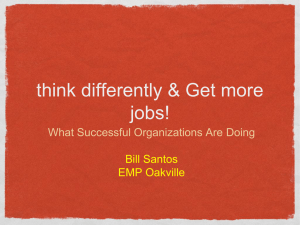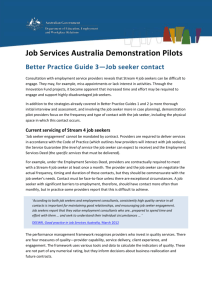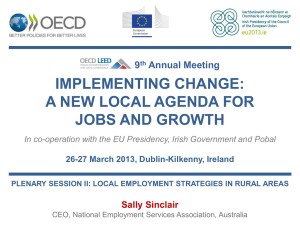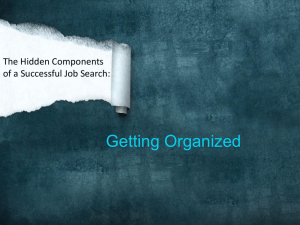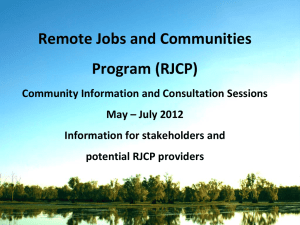Better Practice Guide 6—Post
advertisement
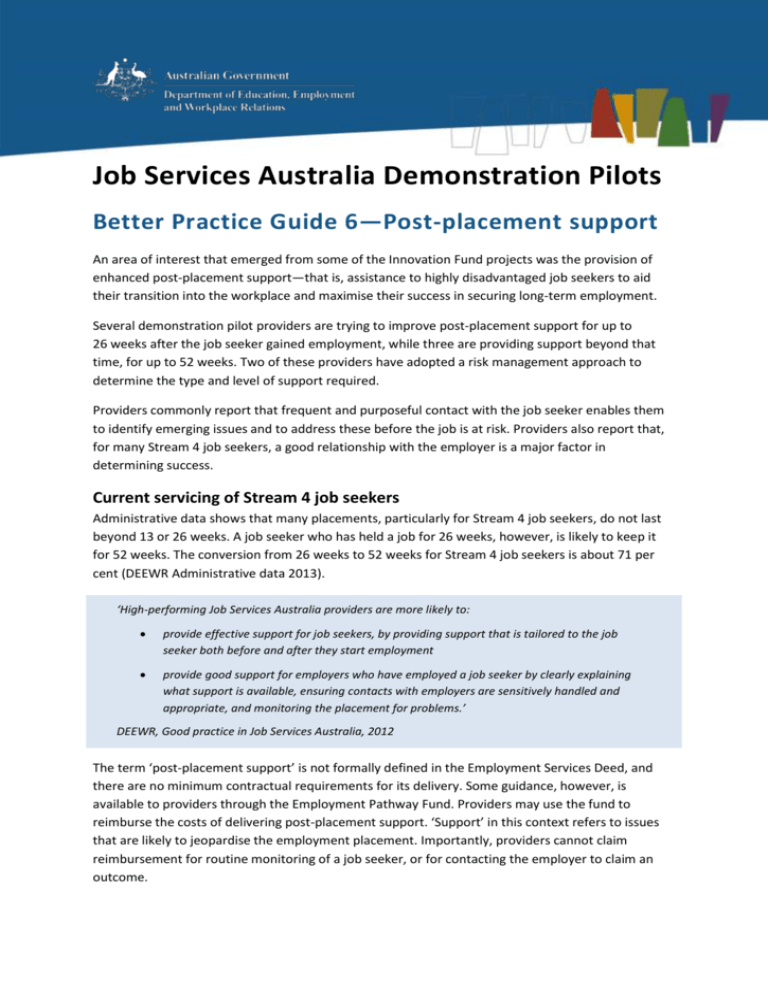
Job Services Australia Demonstration Pilots Better Practice Guide 6—Post-placement support An area of interest that emerged from some of the Innovation Fund projects was the provision of enhanced post-placement support—that is, assistance to highly disadvantaged job seekers to aid their transition into the workplace and maximise their success in securing long-term employment. Several demonstration pilot providers are trying to improve post-placement support for up to 26 weeks after the job seeker gained employment, while three are providing support beyond that time, for up to 52 weeks. Two of these providers have adopted a risk management approach to determine the type and level of support required. Providers commonly report that frequent and purposeful contact with the job seeker enables them to identify emerging issues and to address these before the job is at risk. Providers also report that, for many Stream 4 job seekers, a good relationship with the employer is a major factor in determining success. Current servicing of Stream 4 job seekers Administrative data shows that many placements, particularly for Stream 4 job seekers, do not last beyond 13 or 26 weeks. A job seeker who has held a job for 26 weeks, however, is likely to keep it for 52 weeks. The conversion from 26 weeks to 52 weeks for Stream 4 job seekers is about 71 per cent (DEEWR Administrative data 2013). ‘High-performing Job Services Australia providers are more likely to: provide effective support for job seekers, by providing support that is tailored to the job seeker both before and after they start employment provide good support for employers who have employed a job seeker by clearly explaining what support is available, ensuring contacts with employers are sensitively handled and appropriate, and monitoring the placement for problems.’ DEEWR, Good practice in Job Services Australia, 2012 The term ‘post-placement support’ is not formally defined in the Employment Services Deed, and there are no minimum contractual requirements for its delivery. Some guidance, however, is available to providers through the Employment Pathway Fund. Providers may use the fund to reimburse the costs of delivering post-placement support. ‘Support’ in this context refers to issues that are likely to jeopardise the employment placement. Importantly, providers cannot claim reimbursement for routine monitoring of a job seeker, or for contacting the employer to claim an outcome. Currently, where a placement is expected to lead to employment, the job seeker is provisionally exited, which suspends their servicing. During this suspension, the provider is not expected to provide post-placement support. Post-placement support often focuses on the job seeker, but high-performing providers place equal emphasis on adequate support for the employer who has taken on the job seeker. See also Better Practice Guide 7—Employer engagement What are the demonstration pilots trialling? A number of demonstration pilot providers are looking at improving post-placement support for up to 26 weeks of employment. Strategies include: visits to local employers before any placement to develop a strong relationship and to improve retention rates for job seekers placed with these employers visits to job seekers at work following placement to identify and deal with any emerging issues in partnership with the employer out-of-hours support for job seekers so they can access help in their free time (for example, a Saturday coffee club) monitoring and support for accommodation. Often the case manager who has placed the job seeker in a job provides support afterwards, but some pilot providers have dedicated staff for this task. A post-placement support officer may have strong connections with employers, and serves as the first point of contact should issues emerge. Three demonstration pilot providers offer post-placement support beyond the standard 26 weeks, for as long as 52 weeks—Mission Australia’s Project Hope, ORS Employment’s Ongoing Support pilot and PVS Workfind’s SUSTAIN pilot. This extended support resembles that provided by Disability Employment Services. Job seekers in the Disability Management Service receive flexible support indefinitely, while those in the Employment Support Service are entitled to a minimum number of contacts from their provider each month, depending on their level of support (also indefinitely). For both groups, ongoing support assessments are conducted every 52 weeks to determine whether support is still required. The pilots are testing whether a similar approach would help job seekers with multiple and complex needs, given that a large proportion of Stream 4 job seekers have a disability or medical condition that is undiagnosed or unstable, and that they face significant non-vocational barriers to employment. ‘Mission Australia believe that a sharper focus on labour market engagement up-front, combined with long-term case management and mentoring support, will drive improved outcomes for long-term and disadvantaged job seekers. This contrasts with the traditional service delivery approach for highly disadvantaged job seekers, which focuses on vocational and non-vocational barriers and case management prior to meaningful labour market engagement. The HOPE Coordinator has a reduced caseload and can travel to meet client for signups and appointments if necessary to allow for flexible servicing arrangements. The HOPE Coordinator continues to maintain contact with job seekers while in post-placement support.’ Mission Australia—Project Hope PVS Workfind’s SUSTAIN and the ORS Group’s Peninsula pilot take a risk management approach to determine the most appropriate type and level of post-placement support. ‘The SUSTAIN pilot is delivering intensive post-placement services using a risk management approach. From job placement to 13-weeks is considered a critical period, with a high rate of fall-out reported for Stream 4 job seekers. Job seekers participating in the pilot are therefore assessed before job placement against the reasons why they previously fell out of employment. At placement, all job seekers are designated as ‘high risk’ and receive daily contact for the first three days in employment, including a face-to-face visit two hours after commencement. The third day involves the administration of a job seeker and employer survey which is used to develop an action plan to address any identified obstacles to sustained employment and identify risk factors. A risk level is determined; the risk level is progressively reduced as employment stabilises. A dedicated Retention Consultant supports job seeker and employer post-placement.’ PVSWorkfind—SUSTAIN pilot ‘The Ongoing Support pilot provides post-placement support for pilot participants for up to 52 weeks, modelled on the Disability Employment Services approach. At the completion of a 26 week employment outcome, participants who are deemed to benefit from ongoing postplacement support, and who volunteer for the program, are referred to the project manager. Once referred into the program, the project manager contacts the participant and arranges for an initial ongoing support assessment to be completed. The initial assessment, developed by ORS Employment, establishes the likelihood of the participant maintaining employment, the severity of the barriers, the potential for the barriers to interfere with the participants’ employment and required services to maintain employment. Based on the assessment, an ongoing post placement support plan is developed to meet the participant’s individual needs over the next 26 weeks.’ ORS Employment—Ongoing Support pilot Early learnings At the interim evaluation stage, it is still too early to report on whether the pilots are improving 13- and 26-week employment outcomes. However, pilots that increase the level, or enhance the type of, post-placement support find that frequent and purposeful contact with job seekers and employers allows them to identify and address emerging issues before the job is in jeopardy and they are optimistic that this will lead to long-term employment. Providers typically comment that establishing a strong relationship with the employer, where possible, can be a strong influence on the achievement of 26 weeks of employment for highly disadvantaged job seekers. For example, one provider reports that an employer was happy to employ a Stream 4 job seeker as long as the job seeker was able to demonstrate employability or ‘soft skills’. The employer appreciated regular contact by a dedicated consultant, who advised the job seeker on behaviour in the workplace and provided relevant training and skills development. Another provider involved the employer in creating a plan for post-placement support for the job seeker. Thus the provider understood the employer’s expectations and needs, and could develop strategies to improve the job seeker’s performance. At this early stage, pilot providers delivering support for up to 52 weeks are optimistic that such interventions will increase the long-term stability of employment for highly disadvantaged job seekers. Some early data is available from ORS Employment’s Ongoing Support trial of post-placement support for job seekers already in employment. In the interim evaluation ORS Employment reported that, after nine months in employment, 75 per cent of job seekers in the pilot had remained ‘offbenefit’. This compared to 43 per cent of job seekers in a control group of Stream 4 job seekers who had achieved outcomes in the same Employment Service Area during the same period. Although only a few job seekers had begun the PVSWorkfind‘s SUSTAIN pilot at the time of the interim evaluation, 37.5 per cent of them had held their jobs for 13 weeks. This compared to 4.9 per cent in a control group of Stream 4 job seekers in the same Employment Service Area. These provisional early findings have caused PVSWorkfind to introduce retention consultants across the organisation. ‘Under the SUSTAIN pilot, a job seeker was experiencing difficulties to constructively manage their anger, which had resulted in previous fallouts from employment. A dedicated Retention Consultant organised for the job seeker to attend anger management training and provided advice on anger management strategies. The consultant asked the job seeker to contact them immediately if they were experiencing difficulties controlling their anger at work. The Retention Consultant was able to go to the workplace and mediate situations, if needed. The pilot reported that this particular job seeker has achieved 26 weeks of employment, is now in stable housing, reduced his drug intake, and improved his personal financial position and his relationship with his partner and mother.’ PVSWorkfind—SUSTAIN pilot Implications for 2015 Although it is too early to draw firm conclusions, pilot providers report that enhanced postplacement support leads to early identification and resolution of issues for Stream 4 job seekers and strengthens relationships with employers. Providers who deliver continuing support (beyond 26 weeks) report positive signs for Stream 4 pilot participants, compared to a control group. Currently, the Employment Services Deed and guidelines are silent on expectations for postplacement support. Establishing clear expectations, based on the examples of high-performing providers, may improve consistency in post-placement support across the entire program. These Better Practice Guides reflect the processes and strategies providers have used to deliver services under the Job Service Australia Demonstration Pilots. They are not intended to offer evidence about the performance of the pilots. The Guides disaggregate pilot services into distinct service elements to aid in presentation and reference only. Interactions occur between all aspects of services and all areas should be considered when looking at the provision of good practice services to highly disadvantaged job seekers.
